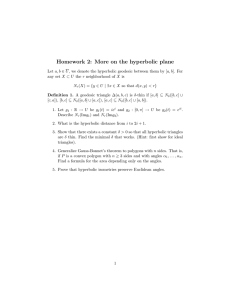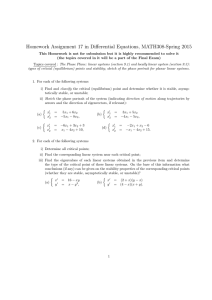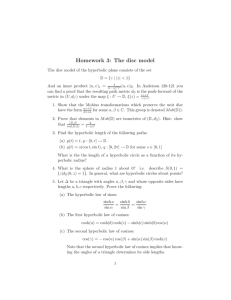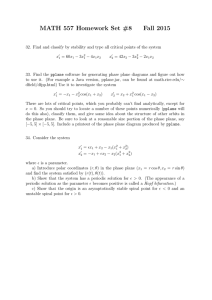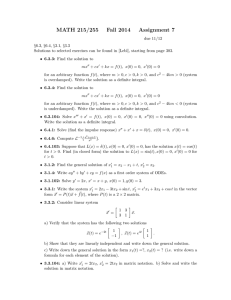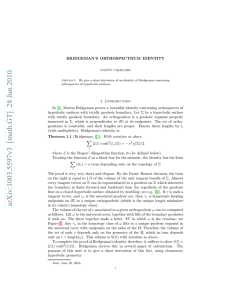Homework 4: The Classification of Isometries and incomplete hyperbolic surfaces.
advertisement
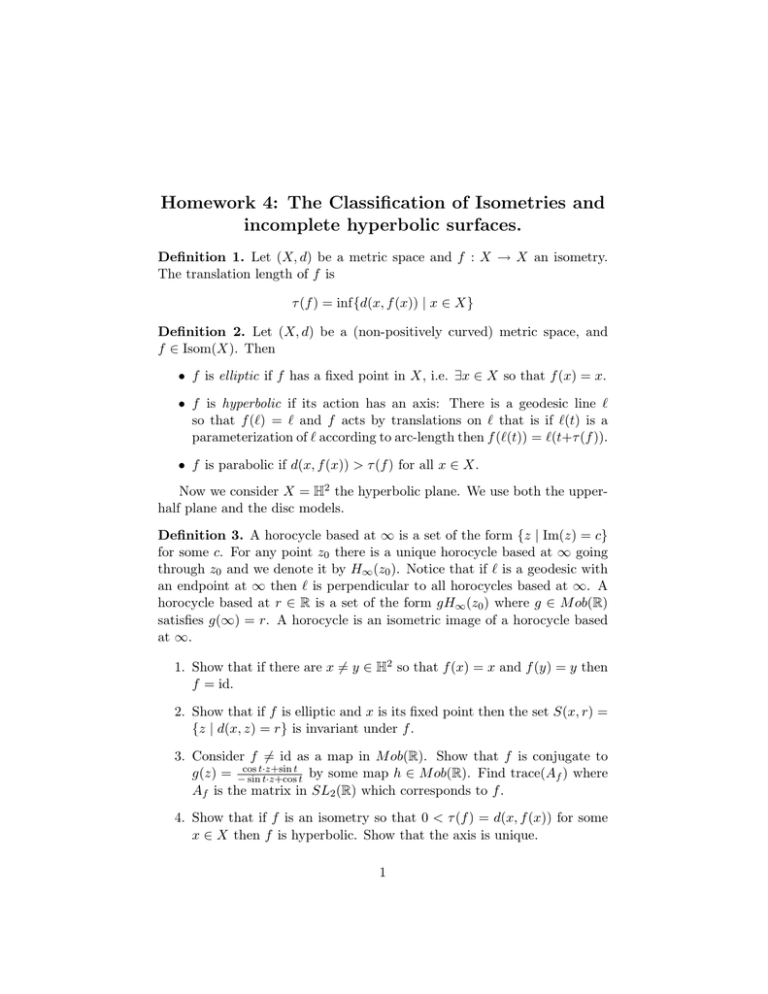
Homework 4: The Classification of Isometries and
incomplete hyperbolic surfaces.
Definition 1. Let (X, d) be a metric space and f : X → X an isometry.
The translation length of f is
τ (f ) = inf{d(x, f (x)) | x ∈ X}
Definition 2. Let (X, d) be a (non-positively curved) metric space, and
f ∈ Isom(X). Then
• f is elliptic if f has a fixed point in X, i.e. ∃x ∈ X so that f (x) = x.
• f is hyperbolic if its action has an axis: There is a geodesic line `
so that f (`) = ` and f acts by translations on ` that is if `(t) is a
parameterization of ` according to arc-length then f (`(t)) = `(t+τ (f )).
• f is parabolic if d(x, f (x)) > τ (f ) for all x ∈ X.
Now we consider X = H2 the hyperbolic plane. We use both the upperhalf plane and the disc models.
Definition 3. A horocycle based at ∞ is a set of the form {z | Im(z) = c}
for some c. For any point z0 there is a unique horocycle based at ∞ going
through z0 and we denote it by H∞ (z0 ). Notice that if ` is a geodesic with
an endpoint at ∞ then ` is perpendicular to all horocycles based at ∞. A
horocycle based at r ∈ R is a set of the form gH∞ (z0 ) where g ∈ M ob(R)
satisfies g(∞) = r. A horocycle is an isometric image of a horocycle based
at ∞.
1. Show that if there are x 6= y ∈ H2 so that f (x) = x and f (y) = y then
f = id.
2. Show that if f is elliptic and x is its fixed point then the set S(x, r) =
{z | d(x, z) = r} is invariant under f .
3. Consider f 6= id as a map in M ob(R). Show that f is conjugate to
t·z+sin t
g(z) = −cos
sin t·z+cos t by some map h ∈ M ob(R). Find trace(Af ) where
Af is the matrix in SL2 (R) which corresponds to f .
4. Show that if f is an isometry so that 0 < τ (f ) = d(x, f (x)) for some
x ∈ X then f is hyperbolic. Show that the axis is unique.
1
5. Show that if f is hyperbolic then it is conjugate to g(z) = λz for some
λ ∈ R. Find trace(Af ).
6. Show that if f is parabolic then there is a point x ∈ ∂U so that
f (x) = x. Prove that f is conjugate to g(z) = z + c for some c ∈ R.
Find trace(Af ).
7. Consider the ideal
lines:
l1
l2
l3
l4
Let f (z) =
4z+1
z+1
quadrilateral bounded by the following geodesic
= {cos t + i sin t | 0 < t < π}
= {z | Re{z} = 3}
= {2 + cos t + i sin t | 0 < t < π}
= {z | Re{z} = −1}
and g(z) =
4z−6
−z+3 .
(a) Draw a sketch of this quadrilateral, and show that f takes l1 to
l2 and g takes l3 to l4 . Find f −1 and g −1 . What is the topological space obtained by this gluing? Does the gluing induce a
hyperbolic metric on this surface?
(b) Find f (i) and g(2 + i)
(c) Let x1 = 3 + 2i. We construct a sequence x1 , x01 , . . . , x4 , x04 as
follows. Let x1 = 3 + 23 i ∈ l2 let x01 = f −1 (x1 ) ∈ l1 . Let x2
be the unique point of H−1 (x01 ) ∩ l4 . x02 = g −1 (x02 ) and {x3 } =
H1 (x02 ) ∩ l1 . x03 = f (x3 ) and x4 = H3 (x4 ) ∩ l3 . Let x04 = g(x4 )
and x0 = H∞ (x1 ) ∩ l4 . Notice that x0 , x04 ∈ l4 . Prove that
Imx0 < Imx04 .
(d) Suppose y1 was a different point in l2 and construct a similar sequence y1 , y10 , . . . , y4 , y40 and y0 . Prove that d(x0 , x04 ) = d(y0 , y40 ).
This number is the gluing invariant at ∞ denoted d[∞].
(e) Suppose we continue this sequence x1 , x01 , . . . , xn , x0n , . . . prove
that the sequence {x4m }∞
m=1 descends to a Cauchy sequence on
the glued surface which doesn’t converge to any point.
This construction shows that if the gluing invariant is not zero, then
the glued hyperbolic surface is incomplete.
2
